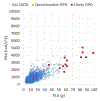High Energy Side and Rear American Football Head Impacts Cause Obvious Performance Decrement on Video
- PMID: 33111969
- PMCID: PMC7674260
- DOI: 10.1007/s10439-020-02640-8
High Energy Side and Rear American Football Head Impacts Cause Obvious Performance Decrement on Video
Abstract
The objective of this study was to compare head impact data acquired with an impact monitoring mouthguard (IMM) to the video-observed behavior of athletes' post-collision relative to their pre-collision behaviors. A total of n = 83 college and high school American football players wore the IMM and were video-recorded over 260 athlete-exposures. Ex-athletes and clinicians reviewed the video in a two-step process and categorized abnormal post-collision behaviors according to previously published Obvious Performance Decrement (OPD) definitions. Engineers qualitatively reviewed datasets to check head impact and non-head impact signal frequency and magnitude. The ex-athlete reviewers identified 2305 head impacts and 16 potential OPD impacts, 13 of which were separately categorized as Likely-OPD impacts by the clinical reviewers. All 13 Likely-OPD impacts were in the top 1% of impacts measured by the IMM (ranges 40-100 g, 3.3-7.0 m/s and 35-118 J) and 12 of the 13 impacts (92%) were to the side or rear of the head. These findings require confirmation in a larger data set before proposing any type of OPD impact magnitude or direction threshold exists. However, OPD cases in this study compare favorably with previously published impact monitoring studies in high school and college American football players that looked for OPD signs, impact magnitude and direction. Our OPD findings also compare well with NFL reconstruction studies for ranges of concussion and sub-concussive impact magnitudes in side/rear collisions, as well as prior theory, analytical models and empirical research that suggest a directional sensitivity to brain injury exists for single high-energy impacts.
Keywords: American football; Concussion; Head impact sensor; Mouthguard; Obvious performance decrement; Video review.
Conflict of interest statement
CONFLICT OF INTEREST STATEMENT
No benefits in any form have been or will be received from a commercial party related directly or indirectly to the subject of the manuscript. Cleveland Clinic has entered into an exclusive license agreement with Prevent Biometrics for instrumented mouthguard technology on which AB, EB and VM are inventors. AB is also an employee of Prevent Biometrics. The conflicts disclosed here are managed by the Cleveland Clinic Conflict Management Board. Complete details can be found at
Figures








References
-
- Centers for Disease Control. Nonfatal sports and recreation related traumatic brain injuries among children and adolescents treated in emergency departments in the United States, 2001–2009. United States Centers for Disease Control and Prevention-Morbidity and Mortality Weekly Report (MMWR); 2011. Report No.: MMWR 60(39). - PubMed
-
- Langlois JA, Rutland-Brown W, Wald MM. The epidemiology and impact of traumatic brain injury: a brief overview. J Head Trauma Rehabil. 2006; 21:375–8. - PubMed
-
- McCrea M, Hammeke T, Olsen G, Leo P, Guskiewicz K. Unreported concussion in high school football players: implications for prevention. Clin J Sport Med. 2004; 14:13–7. - PubMed
-
- Kerr ZY, Register-Mihalik JK, Kay MC, DeFreese JD, Marshall SW, Guskiewicz KM. Concussion nondisclosure during professional career among a cohort of former National Football League athletes. Am J Sports Med. 2018;46(1): 22–29. - PubMed
Publication types
MeSH terms
Grants and funding
LinkOut - more resources
Full Text Sources
Medical

